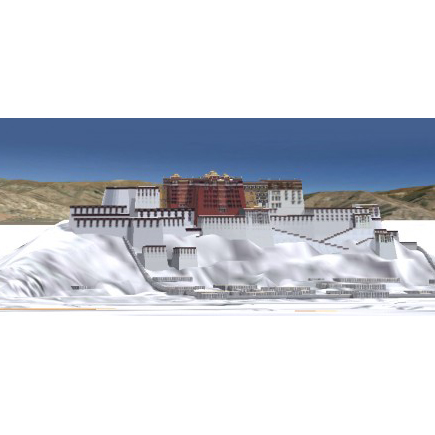
Virtual reality and immersive technologies are beginning to challenge the traditional ways that we consume entertainment, learn, and see the world. Readily available apps can empower you to virtually visit any city on earth with the tap of a finger. However, there are some places that can’t be photographed with a 360° camera. What if you wanted to see a city the way it existed hundreds of years ago?
Virtual Lhasa, a collaborative project led by David Germano and Kurtis Schaeffer from the University of Virginia, aims to present academic research and historical media depicting Lhasa through an immersive virtual experience. Read on to learn about the important transformations that Lhasa underwent during the 17th century and how the Virtual Lhasa experience was built to demonstrate this moment in time.
What is Virtual Lhasa?
As a centuries-old center for a range of religious, economic, and political perspectives, Lhasa has also long been a central city in Asia from its historical roots in the 7th century to the present. It is the location of what were two of the continent’s largest monasteries (Sera and Drepung), three UNESCO World Heritage sites (the Potala Palace, the Norbulingka Palace, and the Jokhang Temple), and, until 1959, the seat of the Dalai Lama’s government’s political power until 1959.
How did Lhasa, one of the most important cities in the vast Tibetan plateau, look during the 17th century? How did residents feel as the towering Potala Palace took shape on Marpori, a site with deep rooted connections to Imperial Tibet? The multidisciplinary Virtual Lhasa project draws on centuries of maps, travel accounts, and other resources to produce a comprehensive reconstruction of the Lhasa-Kyichu Valley as it was known in the late 19th and early 20th centuries. These materials then provide the basis to create a virtual rendering of the city’s 17th-century condition.
The Virtual Lhasa project focuses on a critical point in the city’s history and employs digital technologies to explore not only the changes within the built and natural environments during this time, but also the human pathways within those environments. The project seeks to present how inhabitants and pilgrims alike encountered Lhasa between 1642 and 1705 when the city was undergoing a mammoth revisioning of its landscape and of Tibetan Buddhism itself. Visitors to that newly emerging Lhasa would find themselves before the Potala, an unprecedented architectural presence emotionally charged by the most potent symbols and stories of Buddhism. Given the scale of changes impacting the city at that time, we are virtually reconstructing the valley as it was before and after the Potala’s construction, which allows viewers to more directly understand the impacts these changes had on the physical, emotional, and conceptual environments.
Potala and the New Lhasa of the 17th Century

The Potala was the most prominent visual component of a sixty-four-year process (1642-1705) that saw the founding and consolidation of the Ganden Palace state, an undertaking that involved dramatic military conflicts and new political-religious alliances, alongside a complex building and rerouting agenda in the Lhasa valley.
The Buddhist notion of “pure lands”—celestial realms understood to be created by Buddhas as optimal rebirth destinations for devotees—were explicitly used to model historical polities. Avalokiteshvara’s pure land was called “Potala,” and the 17th-century building of a dramatic palace by the same name was rooted in an attempt to conflate the physical place with the celestial realm. The Potala’s location atop Marpori, the famed Tibetan imperial site, echoed the belief that Tibetan emperors were, like the Dalai Lama, incarnations of Avalokiteshvara.
Around this new center, the Dalai Lama created new institutions such as a medical college complex on the adjacent Chakpori Mountain, and developed the existing urban landscape of Lhasa, including a major expansion of the Jokhang temple complex and the surrounding Barkhor, an assemblage of temples and aristocratic residences. He also expanded the nearby Drepung and Sera monastic residences, setting the stage for them to become major seats of integrated religious and political force in their own right.
In essence, a new virtual Lhasa—as both a Buddhist pure land and a beneficent Tibetan state—were created with buildings, sacred traffic networks, literary narratives, and artistic representations that centered around a god and his human incarnation.
A Multi-Dimensional Representation of a Multi-Dimensional City
Using present-day observation, we can imagine the Potala-dominated Lhasa of 1705, but it is much harder to conceive of the Lhasa of 1642 when the city revolved around a fundamentally different axis. A thorough comprehension of the geomantic, emotional and ritual markers that reshaped the Buddhist experience of movement and vision throughout the religio-political city requires a multi-dimensional representation. The virtual world experience will be integrated with geo-referenced access to large repositories of images, audio-video recordings, visualizations, primary texts, scholarly essays, structured data, Tibetan historical dictionary, map archive, and granular gazetteer. Our intention is thus not to focus on a “pure” immersive experience of Lhasa, but rather a profoundly interwoven presentation of data, media, scholarship, and immersive experience. It is the combination, rather than merely the immersive experience by itself, which constitutes a unique research environment and methodology in service of our assessment of the precise ways, and motivations for the extensive reshaping of the built environment and human pathways through it during this seminal sixty-four-year period.

Explore images of Lhasa and its monuments in the exhibition Monumental Lhasa: Fortress, Palace, Temple on view until January 9, 2017.
Virtual Lhasa is a collaborative project based at the University of Virginia and directed by David Germano and Kurtis Schaeffer. Find out more, and take a virtual tour of Lhasa.

